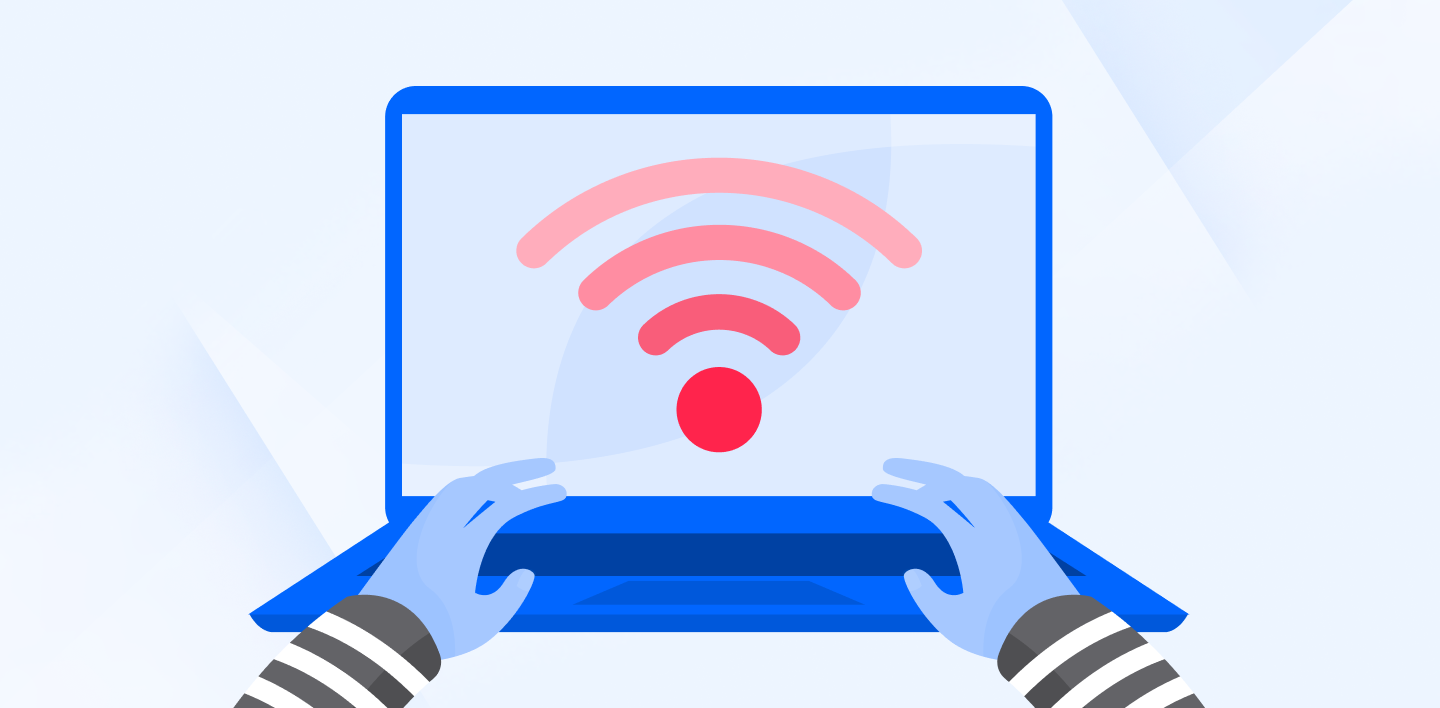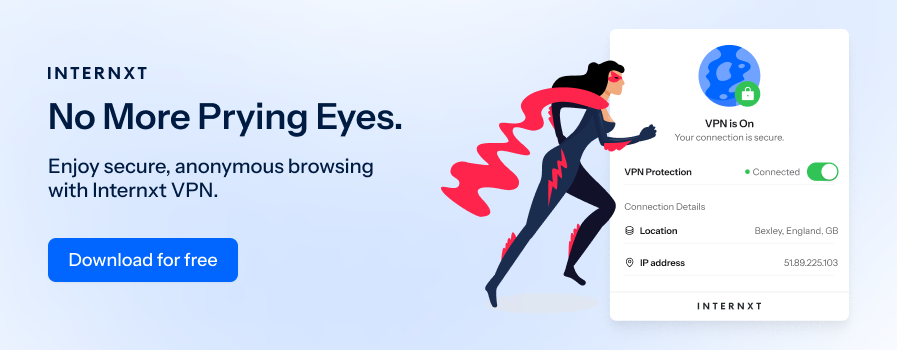How a Wi-Fi Hacker Accesses your Network and How to Prevent it

When we’re away from the security of our homes and workplaces, we will often let our guard down when we’re surfing online. Whether relaxing in your favorite coffee shop, or living the dream at your favorite vacation spot, the last thing on your mind is getting hacked.
But this is when a Wi-Fi hacker can achieve the most success because despite the risks of public Wi-Fi, 81% will happily connect to it, and 99% will connect without a VPN. As a result, a Wi-Fi hacker will target these areas to take over your Wi-Fi connection, leaving you vulnerable to all kinds of attacks.
To fully understand the risks of a Wi-Fi hacker, we will examine exactly how they hack your Wi-Fi so you can take measures to protect yourself and your files online.
Table of contents
- Use a VPN
- Share files with encryption
- Use a secure Wi-Fi router
- Use Multi-Factor Authentication (MFA)
- Set up a strong network key
- Regularly update your router
- Set up a guest network for your business
Different types of Wi-Fi hackers
Not all hackers have malicious intent; a few groups work for organizations to target and report vulnerabilities, strengthen access points, and eliminate vulnerabilities against ransomware, phishing, and other threats.
Different hackers can access your Wi-Fi in different ways with different end goals, so to understand the threats your network faces, we will first look at the different kinds of hackers.
Script kiddie
A script kiddie is an inexperienced Wi-Fi hacker who relies on pre-written scripts obtained from forums, hacking websites, or advanced hackers who share their scripts online.
As the name kiddie suggests, they are inexperienced hackers who lack technical knowledge and understanding of the intricacies of hacking, so they target networks with weak security and people who lack efficient cyber hygiene, such as strong passwords, to hack networks.
Due to this lack of knowledge, script kiddies pose less risk than your expert Wi-Fi password hacker. Furthermore, their actions are easily detectable by monitoring tools or intrusion detection systems. However, they can still be risky for users using public Wi-Fi without password or VPN protection.
Black hat hackers
Black hat hackers are more experienced, malicious hackers who exploit network vulnerabilities to steal sensitive data, passwords, credit card details, or private messages for personal gain.
This kind of Wi-fi password hacker uses advanced techniques to hack into Wi-Fi systems that range from public to corporate networks.
Techniques can be as simple as watching your screen as you enter your password or other methods known as shoulder surfing or exploiting outdated encryption protocols to take advantage of a router’s vulnerabilities.
Other tools they may use are packet sniffers, which catch unencrypted data transmitted over a network, or even Evil Twin attacks, which create a fake hotspot to catch unsuspecting users to connect and unknowingly share their data.
Ethical hackers
White hackers, sometimes called ethical hackers, are certified cybersecurity professionals who work with businesses to protect and secure against malicious Wi-Fi hackers rather than exploit them. An ethical hacker works with the network owner's permission and operates in alignment with legal and ethical boundaries.
A white hat hacker may use penetration testing tools to simulate attacks on Wi-Fi networks to report weaknesses in encryption, password protocols, or router or access point configurations. They will also analyze the impact of potential threats, such as a Wi-Fi password hacker using brute force attacks or man-in-the-middle exploits, and recommend immediate action to prevent these threats.

Internxt has interviewed hackers in the past. To learn more about a hacker's day-to-day life, check out the full interview with an ethical hacker.
Grey hat hackers
Grey hats are the middle ground between white hat and black hat hackers. They work without the explicit permission white hats have, but they may not necessarily work with malicious intent.
This kind of Wi-Fi hacker may exploit weaknesses to find security flaws. They will sometimes notify the network owner about the issue or even publicly disclose it so the company can take action.
The line between what is ethical and what isn’t is often blurred with grey hat hackers. Some do it to try and gain attention for their work, while others hack the system without permission but notify the company of vulnerabilities.
As a compromise, some companies offer bug bounty programs, where hackers can test their skills and try to hack a network or system in return for a financial reward.
Insider hackers
Insider hackers are people with authorized access to a network, such as employees or contractors with internal credentials. They violate their trust by stealing sensitive information for financial gain or grievances against the company.
Unlike outside threats, insider hackers are familiar with the organization’s systems and processes. They may also sometimes work with external hackers, as they can blend in and use their credentials without being spotted or arousing suspicion to access sensitive information.
Zero-trust policies will limit an employees access and prevent the spread of hackers across the system to reduce the threats of insider hackers.
How does a Wi-Fi hacker access a network?
A cybercriminal or Wi-Fi password hacker will decide whether to attack a network or devices connected to the Wi-Fi, looking for the weakest leak or for somebody connected to the network to make a mistake.
The core activities are the steps a Wi-Fi hacker takes when accessing a network are:
- Reconnaissance: The hacker researches and collects information about the network, such as its network name, signal strength, and other details, to identify potential vulnerabilities.
- Identify vulnerabilities: Next, the hacker searches for outdated encryption protocols, weak passwords, and other things that can be exploited to gain unauthorized access.
- Exploitation: After the previous two steps, the Wi-Fi hacker uses tools like password-cracking or other software to access or monitor the connection.
- Reporting: Depending on the kind of hacker, they may report and document their findings or build on their access to spread malware, ransomware, or steal information.
- Fixing the problem: If its an ethical hacker or grey hat hacker, they may report these vulnerabilities so action can be taken. If not, a hacker would cover their tracks and continue to exploit the network for personal gain.

A more advanced and knowledgeable Wi-Fi hacker could use their access for further attacks, such as:
- Escalate the attack: Once accessed, the hacker will try to gain higher access, typically administrator or root access, to control more devices and create more damage.
- Lateral movement: A hacker will also work to spread through the network to other systems and devices to gather more data and exploit other vulnerabilities.
- Export data: hackers will also attempt to steal sensitive data, login details, finances, or intellectual property for their own gain.
- Leave the network open: A malicious hacker could also install backdoors or create other ways to re-enter the network in the future, even if their initial access is discovered and shut down.
Once a Wi-Fi password or other threat actor accesses the network, very rarely is that the end of the attack. So, you should take measures before and during connecting to Wi-fi to protect and recover your accounts from disaster when connecting online.
7 ways to stop a Wi-Fi hacker from accessing your network
So, now we know the basics of what a Wi-Fi hacker may do to try and access your network; how can you prevent it? Here are some ways individuals and businesses can prevent cyberattacks easily.
Use a VPN
Internxt's encrypted VPN is the best way to secure your connection, hide your IP on public networks, and prevent hackers from accessing and stealing your information by scrambling all data sent via the Internet. There are no data trackers, ads, or other risks to your data; everything is kept totally secure and private.
Share files with encryption
A Wi-Fi hacker could view data you transfer over the Internet, intercept and access any files you share, including emails, photos, or other folders you share with others, and even view the files you share with others.
To prevent this, end-to-end encrypted services such as Internxt Drive and Internxt Send can be used to store and share files. Internxt cloud storage for individuals and businesses encrypts files on your device, hiding their contents before they are sent to the Internet and protecting them from hackers.
Use a secure Wi-Fi router
Although you can’t control what kind of router is used for public wi-fi, to protect your business or home from a Wi-Fi hacker, you should investigate which is the best secure Wi-Fi router for your needs.
The best ones include WPA3 encryption, the most advanced and secure encryption to protect data on a Wi-Fi network. Additionally, routers will include firewalls to block and prevent external threats.
Check our list of secure Wi-Fi routers for more information.
Use Multi-Factor Authentication (MFA)
Never rely on a password or passphrase alone to secure your accounts. Hackers use the most advanced software methods available to try to break them, so your best option is to add MFA to all your accounts that hold any sensitive data.
Even if they get access to your password, access can be denied with the second form or authentication that the account holder is in control over.

Set up a strong network key
Always change your network key (Wi-Fi password) from the default login credentials to a unique password that you change periodically. Default passwords are easier to crack, and are sometimes easily available online.
Regularly update your router
Keep up with software updates for your Wi-Fi routers and the devices connected to them, as outdated software may have vulnerabilities that hackers may exploit. By keeping all your devices, networks, and infrastructures up to date, you’re ensuring you have the best security to keep hackers at bay.
Set up a guest network for your business
Businesses should set up a separate guest network, as a Wi-Fi hacker will want to gain business information and access sensitive areas or wireless access points to make their attack worthwhile. By separating and hiding your network, you can prevent lateral access that could spread malware and ransomware, steal data, and set up backdoors for future attacks.

Conclusion
As we have learned, everybody is at risk of a Wi-Fi hacker, from the average Joe at the coffee shop to corporate CEOs. Nobody is safe. We can only prevent cybercriminals by using secure and private products to protect ourselves online.
Fortunately, companies like Internxt offer secure and private cloud storage and a whole suite of tools to help you stay safe online, from our VPN, Virus Scanner, Password Generator, and more. Subscribe to Internxt to help spread awareness of creating a safer, more secure internet.

